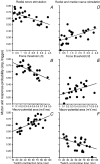Distribution of presynaptic inhibition on type-identified motoneurones in the extensor carpi radialis pool in man
- PMID: 10618157
- PMCID: PMC2269738
- DOI: 10.1111/j.1469-7793.2000.t01-1-00125.xm
Distribution of presynaptic inhibition on type-identified motoneurones in the extensor carpi radialis pool in man
Abstract
The question was addressed as to whether the magnitude of Ia presynaptic inhibition might depend on the type of motor unit activated during voluntary contraction in the wrist extensor muscles. For this purpose, we investigated the effects of applying electrical stimulation to the median nerve on the responses of 25 identified motor units to radial nerve stimulation delivered 20 ms after a conditioning stimulation. The reflex responses of the motor units yielded peaks in the post-stimulus time histograms with latencies compatible with monosynaptic activation. Although median nerve stimulation did not affect the motoneurone net excitatory drive assessed from the mean duration of the inter-spike interval, it led to a decrease in the contents of the first two 0.25 ms bins of the peak. This decrease may be consistent with the Ia presynaptic inhibition known to occur under these stimulation conditions. In the trials in which the median nerve was being stimulated, the finding that the response probability of the motor units, even in their monosynaptic components, tended to increase as their force threshold and their macro-potential area increased and as their twitch contraction time decreased suggests that the median nerve stimulation may have altered the efficiency with which the Ia inputs recruited the motoneurones in the pool. These effects were consistently observed in seven pairs of motor units each consisting of one slow and one fast contracting motor unit which were simultaneously tested, which suggests that the magnitude of the Ia presynaptic inhibition may depend on the type of motor unit tested rather than on the motoneurone pool excitatory drive. The present data suggest for the first time that in humans, the Ia presynaptic inhibition may show an upward gradient working from fast to slow contracting motor units which is able to compensate for the downward gradient in monosynaptic reflex excitation from 'slow' to 'fast' motor units. From a functional point of view, a weaker Ia presynaptic inhibition acting on the fast contracting motor units may contribute to improving the proprioceptive assistance to the wrist myotatic unit when the contraction force has to be increased.
Figures





References
-
- Awiszus F, Feistner H. The relationship between estimates of Ia-EPSP amplitude and conduction velocity in human soleus motoneurons. Experimental Brain Research. 1993;95:365–370. - PubMed
-
- Burke D, Gandevia SC, Mckeon B. Monosynaptic and oligosynaptic contributions to human ankle jerk and H-reflex. Journal of Neurophysiology. 1984;52:435–448. - PubMed
Publication types
MeSH terms
LinkOut - more resources
Full Text Sources

